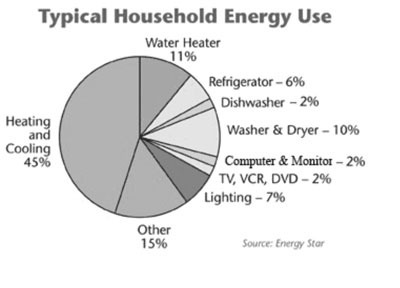By Doug Poole
Member of the Islands’ Energy Coalition
Happy New Year from the Energy Matters crew.
With the holidays behind us and winter in full swing, we thought it would be a good time to talk a little about home heating.
The steps to saving energy are often small and incremental, so let’s look at how we can ratchet down heating energy one click at a time. Reducing your home’s energy use for heating can save you money, improve health, and even increase your home’s comfort.
According to the Department of Energy, heating is the biggest piece of the home energy pie and accounts for around 45 percent of our total energy consumption.
Reducing the energy used for home heating is the single most effective way to save money and ease your home’s contribution to global environmental concerns.
There are many benefits to keeping your home warm in the winter, beyond your obvious comfort.
When outdoor temperatures drop, our homes need to be kept warm to prevent mold and mildew growth. Cold indoor temperatures can more easily reach dew point, creating unhealthy condensation.
To keep the air healthy, indoor temperatures in the winter should range between 65-70 degrees Fahrenheit and humidity levels 30-60 percent.
How can we reduce our heating bills while effectively maintaining health and comfort?
We have two options: repair or replace.
There are three aspects to any heating system that can be fixed or changed out: source, distribution, or controls. It is important to focus on the big picture. Don’t simply swap out that old furnace (source) without sealing your ductwork (distribution), or you will just keep sending expensive heat into the crawlspace through all the duct leaks (dollars).
Let’s play with some numbers. If you connect a new 90 percent efficient furnace to an old duct system that is only delivering 70 percent of its heat, the effective efficiency of your new system is only 64 percent.
Also, make sure your installer calculates the size of the system properly, so that the output matches the heat loss of your home. An oversized heating system does not optimize efficiency, and if undersized you will not stay comfortable.
And don’t forget to take steps in reducing heat loss by air sealing and insulating floors, walls and ceiling.
If you’re interested in a low investment with a quality benefit, consider replacing your older thermostat (control). Newer thermostats ensure a higher degree of temperature accuracy and keep the heat more even in the house.
Programmable units will allow you to set lower temperatures in your absence or at night.
An 8 degrees Fahrenheit decrease from your typical setting can save energy and money. There are even “smart” new controls that will learn your habits and anticipate your heating adjustments for you. Kinda creepy, but cool.
A significant energy reducing step can be found by utilizing Heat Pump technology. A heat pump works just like a refrigerator, but in reverse. An air-source heat pump can deliver 1.5 to 3 times more heat energy to a home than the electrical energy it consumes. This magic is possible because a heat pump moves heat rather than converting it from a fuel. Air-source heat pumps are ideal for our climate.
A heat pump is a good choice when replacing your existing ducted furnace. Or if your current system does not have ducts, such as baseboards or wood heat, a ductless mini-split heat pump provides a very efficient alternative or addition.
While heat pumps are a significant investment, in many cases OPALCO offers rebates to help offset the cost. As an added perk, on the five days in the year we could benefit from cooling our homes, you can run it backwards as an air conditioner.
Keep in mind that your most cost effective measures might be found in adding insulation and air or duct sealing, and that many heating systems require regular servicing in order to maintain maximum efficiency.
For guidance with your specific system, begin with the professional advice available from a $25 OPALCO snapshot or a licensed professional. You can find great tips on saving energy at energystar.gov or feel free to call me at 298-1313.
However you choose to improve upon your current heating system, remember you will be living more comfortably and consuming less energy. Happy heating




